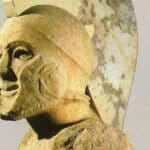Ever wonder what ancient Greek goddesses wore? Or what a king’s bling looked like back then? Forget dusty museum displays – let’s dive into the dazzling world of ancient Greek jewelry! We’re talking intricate gold earrings, necklaces dripping with gemstones, and amazing craftsmanship that’s still mind-blowing today. These weren’t just pretty baubles; they told stories of gods, social status, trade, and the very essence of life in ancient Greece. We’ll explore the materials, the techniques (seriously, the skill involved is impressive!), and what different designs meant. Learn more about ancient Greek women here. Get ready to uncover the secrets hidden in these stunning pieces and see how jewelry reflects the lives and beliefs of people thousands of years ago.
Ancient Greek Jewelry: Timeless Elegance & Symbolism
Let’s journey back in time to explore the dazzling world of ancient Greek jewelry! More than mere ornaments, these pieces were miniature works of art, each whispering stories of gods and goddesses, social standing, and the vibrant tapestry of everyday life in ancient Greece. Picture a delicate gold necklace, intricately crafted with tiny beads, adorning a woman’s neck, or a signet ring bearing a family crest – a glimpse into a world of sophisticated style, cultural identity, and masterful craftsmanship. What makes these ancient artifacts so captivating even today?
Materials and Techniques: Unveiling Artistic Processes
Ancient Greek artisans were celebrated masters of their craft, transforming precious metals and gemstones into breathtaking creations that have stood the test of time. Gold and silver were at the forefront, frequently used to create stunning necklaces, earrings, bracelets, rings, and diadems. But what truly set their jewelry apart were the ingenious and remarkably sophisticated techniques they employed, many of which are still admired and replicated today. How did they achieve such delicate and intricate designs with the relatively limited tools available to them?
Consider granulation (fusing tiny gold beads together), where thousands of minuscule gold beads were painstakingly fused together to create shimmering, granulated surfaces that catch the light in the most captivating way. Or filigree (delicate metal wirework), a mesmerizing latticework of delicate gold wires, forming intricate patterns, floral motifs, and complex geometric designs. And repoussé (hammering metal from behind), where the metal was skillfully hammered from behind to create raised three-dimensional images, adding depth, texture, and a sense of dynamism to the pieces. These weren’t mass-produced items; each piece represents hours, maybe even days, of skilled handiwork, a testament to the dedication and artistry of the craftsmen.
However, their artistry wasn’t limited to just gold and silver. Picture vibrant emeralds, deep red garnets, and lustrous pearls, adding pops of color, brilliance, and a touch of exotic allure to their creations. Some pieces even incorporated semi-precious stones like amethyst, carnelian, and lapis lazuli, showcasing the diversity of their resources and their skill in utilizing whatever materials were at hand, both locally sourced and acquired through trade. These weren’t just accessories; these were miniature sculptures, wearable art that reflected the advanced metalworking skills, sophisticated aesthetic sensibilities, and access to a global trade network that characterized the era. Did the availability of these materials influence the techniques used and the regional styles that emerged?
Symbolism and Meaning: Interpreting Cultural Narratives
Ancient Greek jewelry wasn’t simply decorative; it was laden with symbolism, each piece conveying meaning far beyond its aesthetic appeal. Animals, plants, gods, goddesses, and mythical creatures were all frequently depicted, each carrying its own specific cultural weight and significance. For example, lions often symbolized strength, courage, and royalty, while snakes might represent healing, rebirth, or the power of the underworld. Owls were associated with wisdom and the goddess Athena, while doves were linked to love and the goddess Aphrodite. The intricate Herakles knot (interwoven design), a complex interwoven design, is often interpreted as a symbol of marriage, enduring bonds, or the strength of the hero Herakles himself. What stories did these symbols tell about the values, beliefs, and aspirations of ancient Greek society?
However, interpreting these symbols isn’t always straightforward. Scholars continue to debate the precise meaning of certain designs, highlighting the rich layers of symbolism embedded within each piece. Regional variations in style also add to the complexity, suggesting different cultural nuances, traditions, and local interpretations across various city-states and regions. The more we discover through archaeology and textual analysis, the more layers of meaning seem to unfold! Ongoing research and new discoveries constantly add to our understanding; therefore, our interpretations of some symbols and motifs might evolve over time as new evidence comes to light. Could these symbols have held different meanings for different social classes or within specific religious cults?
Social and Cultural Context: Jewelry as a Reflection of Society
The type of jewelry worn in ancient Greece often served as a clear indicator of a person’s wealth, social standing, and even their religious affiliation. Lavish gold pieces adorned with precious gemstones were typically reserved for the wealthy elite, while simpler silver or bronze jewelry was more common among the general population and enslaved people. Imagine a wealthy matron attending a symposium, wearing a magnificent gold necklace with a large, gleaming emerald pendant and intricate filigree work—a clear and unmistakable statement of her affluence, social status, and refined taste. However, jewelry wasn’t exclusively for the elite. Silver jewelry, for example, was more affordable and widely worn, and even simpler designs could convey personal meaning or religious significance. How did jewelry contribute to the construction of social identity, the expression of personal beliefs, and the reinforcement of social hierarchies in ancient Greece?
Religious beliefs also played a significant role in the selection and wearing of jewelry. Amulets and pendants featuring religious iconography, such as depictions of gods and goddesses or symbols associated with specific deities, served as both adornments and powerful lucky charms, offering spiritual protection, invoking divine blessings, and reinforcing faith. So, jewelry wasn’t just a fashion statement or a display of wealth; it was integrally woven into the fabric of daily life, reflecting religious beliefs, social status, individual preferences, and regional traditions. Did the use of jewelry in religious contexts differ across regions or among various religious cults?
Historical Periods: Tracing the Evolution of Styles
The styles and techniques of ancient Greek jewelry changed significantly throughout history, reflecting shifts in artistic tastes, technological advancements, economic conditions, and evolving cultural influences. How did political and economic changes, such as the rise and fall of empires and the expansion of trade routes, influence jewelry design and the availability of materials?
| Period | Dates (BC) | Characteristics | Example |
|---|---|---|---|
| Minoan-Mycenaean | 2700-1100 | Elaborate gold work, use of granulation, animal and nature motifs | Gold diadems with intricate repoussé designs |
| Geometric | 900-700 | Simplified geometric patterns, use of bronze and iron alongside gold and silver | Bronze fibulae with geometric engravings |
| Archaic | 700-500 | Increased influence from the Near East, introduction of new techniques like filigree | Gold earrings with rosette and animal motifs |
| Classical | 500-323 | Balance, harmony, and idealized forms, emphasis on the human figure | Gold necklaces with fine chain work and gemstone pendants |
| Hellenistic | 323-146 | Opulence, dramatic flair, integration of diverse cultural influences | Elaborate gold jewelry with colorful gemstones and enamel |
The evolution of ancient Greek jewelry offers a captivating glimpse into the changing cultural values, artistic sensibilities, and cross-cultural interactions of each era. Observe how the styles shifted and evolved, reflecting the innovations, influences, and historical events of each time period. Did the influence of other cultures, such as Egypt, Persia, and the Near East, become more pronounced over time, and how did this impact Greek jewelry design?
Enduring Legacy: Appreciating Ancient Craftsmanship
Ancient Greek jewelry continues to captivate, inspire, and influence contemporary design. Its enduring power lies in its ability to bridge the gap between past and present, allowing us to connect with the artistry, beliefs, values, and daily lives of a civilization that flourished millennia ago. These exquisite pieces remain a testament to human creativity, technical skill, and aesthetic vision, leaving behind a legacy of elegance, sophistication, and cultural richness that continues to resonate with us today. Their beauty invites us to reflect on the lives of those who crafted and wore them, offering a tangible link to a rich and fascinating past. The ongoing study of ancient Greek jewelry constantly adds to our understanding, deepening our appreciation with each new discovery and challenging us to re-evaluate our interpretations of these timeless treasures. What lessons can modern artisans learn from the techniques, designs, and symbolic language of ancient Greek jewelry?
How to Authenticate Ancient Greek Jewelry Replicas
Key Takeaways:
- Authenticating ancient Greek jewelry requires a multifaceted approach combining art historical knowledge, scientific analysis, and careful examination of provenance.
- Material analysis is crucial: examine gold purity, granulation techniques, tool marks, patina, and overall craftsmanship.
- Provenance documentation is essential; legitimate pieces often have a verifiable history tracing their ownership and discovery.
- Understanding stylistic changes across various historical periods (Minoan-Mycenaean, Geometric, Archaic, Classical, Hellenistic) is vital for identifying anachronisms and inconsistencies.
- High-value purchases demand professional authentication from reputable experts, while simpler pieces might be more easily assessed by a knowledgeable buyer with experience in ancient art.
- Legal aspects, like UNESCO conventions and export regulations, must be considered to ensure ethical and legal acquisition. Is it always possible to definitively authenticate a piece of ancient jewelry, and what are the limitations of current authentication methods?
Deciphering the Details: Materials and Authenticity
Ever wonder how ancient Greek artisans created such exquisite pieces, and how we can distinguish authentic artifacts from modern replicas? Let’s delve into the craftsmanship and explore the telltale signs of authenticity. Authentic ancient Greek jewelry often showcases distinctive techniques, materials, and subtle imperfections that are difficult to replicate convincingly. Gold, silver, and gemstones were expertly manipulated using techniques like granulation, filigree, repoussé, and chasing. Intricate methods like granulation (tiny beads of metal fused together) and filigree (delicate wirework) created stunning effects that required exceptional skill and precision. Replicas often lack the subtlety, precision, and overall quality of the originals. Look for imperfections, subtle tool marks, and variations in the metalwork – all signs of the human hand and the techniques of antiquity, rather than modern machine production. These subtle details often separate the real from the fake. Could the presence of specific trace elements in the metal composition, detectable through scientific analysis, indicate authenticity and geographical origin?
Unraveling the Symbols: Meaning Confirmation
Ancient Greek jewelry wasn’t merely adornment; it conveyed powerful messages through a rich symbolic language. Recurring motifs like animals (such as eagles, lions, snakes, and dolphins), gods (Zeus, Apollo, Dionysus), and goddesses (Athena, Aphrodite, Hera) offer valuable clues to the piece’s meaning and potential authenticity. These weren’t random choices; each symbol carried cultural weight, religious significance, and social implications. Some motifs reflected religious beliefs, personal affiliations, or social status, while others invoked divine protection or conveyed specific messages. Consider the context: what does the symbol indicate about the wearer’s role in society, their religious beliefs, or their personal aspirations? Is it possible for replicas to accurately reproduce the symbolic nuances, cultural context, and artistic style of original pieces?
Context is King: Social Evidence
The social standing of the wearer in ancient Greece deeply influenced the types of jewelry they wore, the materials used, and the overall design of the pieces. Elaborate pieces made of gold and precious gemstones signified wealth, power, and high social status. More modest designs made of silver, bronze, or less expensive materials were appropriate for everyday wear by ordinary citizens. Consider the historical period as well. Minoan-Mycenaean jewelry, for example, differs significantly from Classical or Hellenistic styles in terms of materials, techniques, and decorative motifs. Changes in technique, design, and symbolic language reflect broader cultural shifts, economic conditions, and evolving artistic sensibilities. Knowing this historical timeline and understanding the social context helps you place a piece in context and assess its potential authenticity. What historical records, archaeological reports, and museum collections can be used to verify the context and authenticity of a piece of jewelry?
Expert Eyes and Scientific Methods: Verification Steps
Authenticating Ancient Greek Jewelry Replicas requires a blend of art historical knowledge, scientific analysis, and careful examination of provenance. Visual inspection by a trained eye is an essential first step. However, for high-value pieces, professional authentication from reputable experts is essential. Non-destructive testing methods such as X-ray fluorescence (XRF) analysis, Raman spectroscopy, and metallographic analysis can determine the precise metal composition, identify the types of gemstones used, and reveal details about the manufacturing techniques. This can reveal whether the materials are consistent with ancient alloys and whether the techniques align with those used in ancient Greece. Professional authentication often includes provenance checks, which trace the ownership history of the item, providing valuable information about its origins, past ownership, and legal status. This documentation significantly strengthens authenticity claims and helps to establish the piece’s legitimacy. What specific skills, knowledge, and ethical standards do professional authenticators possess, and how do they balance art historical expertise with scientific analysis?
Navigating the Market: Risk Mitigation
The market for ancient Greek jewelry is unfortunately susceptible to forgeries, replicas, and misattributed pieces. Reputable dealers, auction houses, and galleries usually provide detailed documentation, provenance information, and authenticity guarantees, offering buyers a degree of protection. Be wary of overly cheap items or those offered by unverified sources; authentic pieces of ancient Greek jewelry are rarely inexpensive due to their historical significance, artistic value, and material composition. Thorough examination, ideally with the assistance of an expert in ancient art, is paramount before making any purchase. Due diligence, including researching the seller, verifying provenance claims, and obtaining professional authentication, greatly reduces the risk of purchasing a forgery or a misrepresented item. What legal protections are in place to prevent the sale of forged ancient artifacts, and what recourse do buyers have if they unknowingly purchase a fake?
Ancient Greek Jewelry Techniques: Granulation, Filigree, and Repoussé Mastery
Key Takeaways:
- Ancient Greek jewelry employed a sophisticated blend of readily available and imported materials, showcasing both indigenous artistry and cross-cultural exchange.
- Ancient Greek Jewelry Techniques: Granulation, Filigree, and Repoussé Mastery represent the pinnacle of ancient metalworking skills, demonstrating remarkable technical sophistication and artistic finesse.
- Jewelry designs held deep symbolic meaning, reflecting Greek mythology, religious beliefs, societal values, and personal aspirations.
- Ancient Greek jewelry functioned as significant status symbols, integral to religious rites, funerary practices, and various social customs.
- The legacy of Ancient Greek jewelry continues to inspire contemporary designers and artisans, influencing modern aesthetics and innovative techniques. How can these ancient techniques be adapted, reinterpreted, and integrated into modern jewelry design to create contemporary pieces with a timeless appeal?
Materials: The Palette of Ancient Jewelers
What materials did ancient Greek artisans favor, and how did their choices reflect the available resources, cultural preferences, and economic realities of the time? Primarily, gold, silver, bronze, and various gemstones formed the foundation of their creations. These metals, readily available through local sources or obtained through extensive trade networks, provided the essential malleability, durability, and aesthetic appeal necessary for their intricate designs. But the artistry soared beyond mere metal; vibrant gemstones like emeralds, garnets, amethysts, sapphires, lapis lazuli, and pearls added dazzling color, symbolic significance, and increased value to their masterpieces. Imagine the gleam of a gold necklace, adorned with carefully selected gems that catch the light and reflect the wearer’s status and taste! The choice of material often reflected the wearer’s status, the intended function of the piece, and the occasion for which it would be worn. Did the availability of certain materials influence regional styles, leading to variations in techniques and aesthetic preferences across different regions of ancient Greece?
Mastering the Techniques: Key Artistic Methods
Ancient Greek artisans were masters of several intricate techniques, demonstrating remarkable skill, precision, and artistic vision in their metalworking practices. Let’s explore three of the most prominent and influential techniques:
-
Granulation: This involved meticulously attaching tiny spheres (granules) of metal, typically gold, to a surface, creating a textured, almost sparkling effect that adds depth and visual interest to the design. Picture a tiny, golden carpet made of countless perfectly formed beads, each carefully placed and fused to the base! The precision required was extraordinary, demanding exceptional patience, dexterity, and control over heat and metal. Could the size of the granules, the density of their arrangement, and the overall pattern affect the aesthetic appeal and perceived value of the piece?
-
Filigree: Think delicate, interwoven strands of metal, typically gold or silver, forming intricate patterns, geometric designs, floral motifs, and narrative scenes. It’s like a metallic lace, delicate yet strong, capable of shaping complex forms and capturing the finest details. The skill involved in creating these fine filigree patterns was unparalleled, requiring a keen eye, steady hands, and a deep understanding of metalworking principles. What tools and techniques were used to create such intricate filigree work, and how did artisans ensure the delicate wires didn’t break or distort during the process?
-
Repoussé: This technique involved hammering metal from the back to create raised designs on the surface, resulting in three-dimensional forms and dynamic compositions. It’s like sculpting with metal, manipulating the material to create intricate details and lifelike representations! The artisans’ skill in controlling the striking force, shaping the metal, and achieving the desired effect is truly impressive. How did artisans ensure the metal didn’t tear, buckle, or distort during the repoussé process, and what techniques did they use to refine the surface and bring out the desired details?
These techniques, often used in combination, resulted in jewelry of breathtaking beauty, complexity, and artistic sophistication.
Symbolism and Social Significance: Jewelry as Communication
Ancient Greek jewelry wasn’t just pretty; it spoke volumes through a rich symbolic language and served as a powerful tool for social communication. Designs held deep symbolic meaning, reflecting Greek mythology, religious beliefs, societal values, and personal aspirations. Medusa heads offered protection against evil, laurel wreaths symbolized victory and achievement, Herakles knots represented strength, marriage, and enduring bonds. Religious symbolism played a substantial role; certain pieces marked affiliations with specific deities, invoked divine blessings, or served as votive offerings. Moreover, the type of jewelry worn—its materials, craftsmanship, and symbolic motifs—signaled social status, wealth, personal identity, and cultural affiliation. A simple bronze ring differed greatly from a gold diadem studded with gems, conveying vastly different messages about the wearer’s position in society and their relationship to the surrounding world. Jewelry’s significance transcended simple adornment; it was a powerful form of self-expression, social communication, and cultural representation. How did the intended recipient, the occasion for which the jewelry was worn, and the prevailing social norms influence the choice of symbols, materials, and overall design?
A Legacy of Craftsmanship: Enduring Principles
The legacy of Ancient Greek jewelry is profoundly captivating, enduring, and influential. Their incredible artistry, technical skill, and the rich symbolism embedded within their work continue to captivate, inspire, and inform contemporary designers, artisans, and scholars. Modern jewelers and artisans are still inspired by their innovative techniques, aesthetic principles, and the timeless beauty of their creations. Many techniques, though time-consuming and demanding, remain relevant to modern jewelry-making, offering valuable insights into the possibilities of metalworking and the power of artistic expression. The study of Ancient Greek jewelry offers insights not only into their craftsmanship but also their culture, beliefs, and worldview, providing a window into a fascinating and influential civilization. It’s a testament to human ingenuity, artistic vision, and the enduring power of artistic expression to transcend time and cultural boundaries. How has the discovery of new archaeological sites, the analysis of existing collections, and the application of advanced technologies influenced our understanding of ancient jewelry techniques and their cultural significance?
Ancient Greek Jewelry Regional Variations: Styles and Motifs Across the Aegean
Key Takeaways:
- Ancient Greek jewelry wasn’t just adornment; it reflected wealth, social status, religious beliefs, regional identities, and evolving artistic sensibilities.
- Materials like gold, silver, bronze, electrum, and various gemstones held symbolic meaning, often linked to mythology, local traditions, and trade networks.
- Advanced techniques like granulation, filigree, repoussé, chasing, and enamel work showcased exceptional craftsmanship and regional specialization.
- Ancient Greek Jewelry Regional Variations: Styles and Motifs Across the Aegean are evident, showcasing diverse artistic expression, cultural influences, and unique regional identities across different regions of the ancient Greek world.
- Jewelry played a significant role in burial practices, religious rituals, social ceremonies, and daily life, offering valuable insights into ancient Greek beliefs, customs, and social structures. How can the study of burial jewelry, religious iconography, and social contexts help us understand ancient Greek beliefs about the afterlife, the divine, and the individual’s place in society?
Materials and Techniques: The Art of Diversity
Imagine the meticulous work involved, the artistic vision, and the technical skill required to create these miniature masterpieces! Ancient Greek artisans skillfully employed a diverse range of materials—gold, silver, bronze, electrum (a natural alloy of gold and silver), and a dazzling array of gleaming gemstones—to create their stunning jewelry. Gold, particularly popular during the Hellenistic period and in regions with abundant gold deposits, symbolized wealth, status, divine power, and immortality. Intricate techniques like granulation (tiny balls of metal fused together), filigree (delicate wirework), repoussé (hammering from the back to create relief), chasing (smoothing and refining the surface), and enamel work (fusing colored glass to metal) elevated their creations to works of art, demonstrating their mastery of metalworking and their sophisticated aesthetic sensibilities. Doesn’t it make you wonder about the countless hours, the unwavering patience, and the deep artistic passion invested in each piece? Did access to specific resources, such as gold, silver, gemstones, and specialized workshops, influence the techniques used and the regional styles that emerged in different parts of the ancient Greek world?
Symbolism and Meaning: Decoding Cultural Expressions
Ancient Greek jewelry wasn’t just beautiful; it was symbolic, serving as a powerful tool for communication, self-expression, and cultural representation. Motifs weren’t random; they conveyed specific meanings, reflecting the wearer’s beliefs, values, and social affiliations. Animals held special significance, each representing specific qualities or attributes. Lions represented courage, strength, and royalty; dolphins symbolized good fortune, maritime power, and safe passage across the sea; snakes represented healing, wisdom, and the power of the underworld. The Herakles knot (marriage and strength), a symbol of marriage, enduring bonds, and the strength of the mythical hero Herakles, frequently adorned rings, necklaces, and bracelets. Gemstones, too, carried symbolic weight; emeralds might represent hope, fertility, and renewal; amethysts protection against intoxication and negative energies; lapis lazuli connection to the divine and knowledge. Every element spoke volumes, revealing the wearer’s identity, beliefs, and social context. How did local myths, legends, religious beliefs, and cultural traditions influence the choice of symbolic motifs and their interpretation in different regions of ancient Greece?
Social and Cultural Context: Weaving Social Narratives
Jewelry’s role in ancient Greek society extended far beyond mere decoration, serving as a multifaceted form of social communication, cultural expression, and economic indicator. It served as a status symbol, with a wealthy woman’s elaborate necklace, adorned with precious gemstones and intricate metalwork, instantly announcing her position, wealth, and refined taste. Religious beliefs were also deeply reflected in jewelry design, with amulets, pendants, and votive offerings dedicated to specific deities providing divine protection and demonstrating piety. International trade and cultural exchange impacted styles, techniques, and materials, with influences from Egypt, Persia, the Near East, and other regions enriching the aesthetics and expanding the repertoire of ancient Greek jewelers. Think of jewelry as a microcosm of ancient Greek life itself, rich with complexity, nuance, and a fascinating interplay of social, economic, religious, and cultural forces. Did the status associated with jewelry differ between men and women, and how did the use of jewelry in religious contexts vary across different regions and among various religious cults?
Regional Variations Across the Aegean: Exploring Stylistic Shifts
Ancient Greek Jewelry Regional Variations: Styles and Motifs Across the Aegean are remarkably diverse and fascinating, reflecting the unique cultural identities, economic conditions, and artistic traditions of different regions of the ancient Greek world. Did you know significant differences existed in the styles, techniques, materials, and decorative motifs of jewelry produced in different regions, such as Crete, Mycenae, Attica, the Cyclades, and the islands of the Aegean? For example, Mycenaean jewelry displays unique characteristics, such as the extensive use of gold, elaborate repoussé designs, and animal and nature motifs, distinct from the later Classical or Hellenistic styles. Investigating these regional differences provides a deeper understanding of the cultural exchanges, trade networks, and independent artistic developments that shaped the diverse landscape of the ancient Greek world. The variations weren’t just stylistic; they likely reflected local beliefs, access to materials, and the influence of neighboring cultures. Further research into these regional variations, utilizing archaeological evidence, textual sources, and comparative analysis, is essential to complete the picture and appreciate the richness and complexity of ancient Greek jewelry. How did trade routes, migration patterns, and political alliances contribute to the spread of stylistic influences and the development of unique regional traditions across the Aegean?
Historical Periods: Time Traveling Through Ancient Styles
Ancient Greek jewelry evolved significantly over centuries, reflecting the dynamic interplay of technological advancements, artistic innovations, political changes, and evolving cultural sensibilities. The Mycenaean period (c. 1600-1100 BCE) displayed distinct styles, utilizing gold extensively, employing elaborate repoussé techniques, and featuring animal and nature motifs. Geometric patterns characterized the following era, with simplified designs and increased use of bronze and iron alongside gold and silver. The Archaic period (c. 700-500 BCE) saw refined techniques, increased influence from the Near East, and the introduction of new techniques like filigree. The Classical period (c. 500-323 BCE) saw refined techniques, more naturalistic designs, and a focus on balance, harmony, and idealized forms. The Hellenistic period (323-31 BCE) reached a peak of extravagance, with lavish use of gemstones, complex designs, and the integration of diverse cultural influences from across the Mediterranean world. This chronological perspective allows us to trace the technological advancements, artistic innovations, and evolving aesthetic preferences that shaped the history of ancient Greek jewelry. What archaeological discoveries, museum collections, and scholarly publications have shed light on the evolution of jewelry styles over time, and how have these discoveries changed our understanding of ancient Greek art and culture?
- Discover Ancient Greece Weapons: A Comprehensive Guide to Military Technology - August 8, 2025
- Discover Ancient Greek Swords: A Comprehensive Guide - August 8, 2025
- Explore Ancient Athens: Unveiling the City’s Secrets Through Maps - August 8, 2025
















